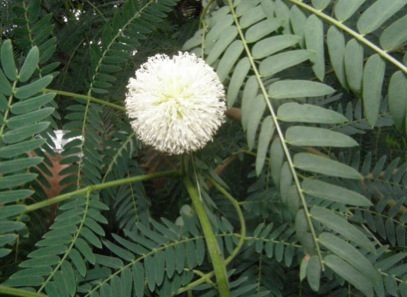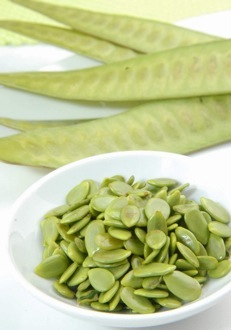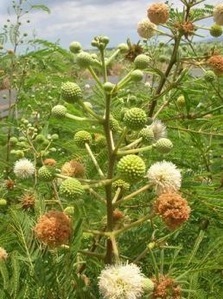Leucaena leucocephala: Food and Fodder
Professor Julia Morton, the grand dame of toxic and edible plants in Florida, had this to say about the Jumbie Bean:
“The plant is toxic to horses, donkeys, mules, and pigs, even to cattle, sheep and goats in quantity. People should not eat any parts raw.”
Not exactly encouraging. But she also says: “Young leaves, pods and seeds cooked and eaten, Mature seeds roasted and used as coffee substitute or adulterant.” Thus we start our review of the Jumbie Bean, the Lead Tree, The White Popinac, the Leucaena leucocephala.
Let’s start with the name. No great inspirations there. Leucaena (lew-KAY-nuh) means to grow white, as to flower. Leucocephala (lew-koh-SEF-uh-luh) means white headed. (Also lew-SEEN-uh.)
Also called Jumbay and the White Leadtree, this native of Central America has sporadically spread its way northwest and east from California to Florida and to the rest of the warm world. The Jumbie Bean was taken to the Philippines in the 1500’s by the Spanish, probably as cattle feed. It spread from there and has become “invasive” in Taiwan, Hawaii, Fiji and northern Australia. In the United States whether it is an invasive is a matter of debate and location.
A different attitude prevails in India where it is well-established and viewed as a resource. There it is used for firewood, fiber, lumber, charcoal and livestock fodder, the latter reported in 1998 which conflicts with Julia’s 1982 comment. Apparently the ruminant bacteria, Synergistes jonesii, helps to detoxify the fodder in multi-stomach animals. It was transferred from American stock to Australia, Africa and China starting in the 1980s to make the plant acceptable fodder in those parts of the world, as it is some 24% protein and loaded with proto-vitamin A. The stomach bacteria helps explain the advantage of multiple stomachs and why the rest of us with only one stomach and no S. jonesii have to cook the plant.
As for toxicity in the raw parts to non-cud chewing mammals, the culprit is mimosine, an amino acid. Wet or dry heat reduces the acid. If you don’t cook it Jumbie vegetation can make you sick and lose your hair, hence the old saying that it causes tails to drop off one-stomach horses.
On the positive side again the tree is a nitrogen fixer and grows very fast, as much as 10 feet a year, which is why it is a renewable firewood and good at preventing soil erosion. It is also used as a shade tree for many commercial crops including coffee, cocoa, quinine and vanilla. It is also used as a hedge to grow passion fruit on. It might be fair to suggest that whether it is a resource or a pest is a matter of attitude.
Don’t confuse this with the False Tamarind which has twisted seed pods, not straight, and cluster of flowers not solitary ones.
Green Deane’s “Itemized” Plant Profile
IDENTIFICATION: A shrub or tree to 60 feet, forked when shrubby, branching strongly after coppicing (cutting to a stump yearly.) Grayish bark and prominent lenticels. Leaves bipinnated with four to nine pairs of pinnae, variable in length up to a foot with a large gland at the base of the petiole, 11-22 pair , flowers numerous.
TIME OF YEAR: Depends on location. It can be year round in warm areas or summer time in more temperate areas.
ENVIRONMENT:Full sun, alkaline soil, enjoys humidity.
METHOD OF PREPARATION: Young leaves, pods and seeds cooked, usually boiled. Mature seeds roasted and used as coffee substitute or popped like pop corn. Dr. Morton say do not consume uncooked. A related edible species is L. esculenta.
Lastly, Leucaena glauca and Leucaena latisilique are now Leucaena leucocephala. Cornucopia II disagrees with Morton and says leucocephala young leaves, pods, and flower buds can be eaten raw, or cooked. Mature seeds but not dry seeds are eaten raw or cooked. Dry seeds are used as a coffee substitute or fermented into a tempeh like product. I’ve never tried them raw, preferring to err on Morton’s side.





Hey Deane, I’m confused. The article is mostly concerned with L. leucocephala, and you state in the Method of Preparation section, “do not consume uncooked.” Then in the next paragraph, you state “L. leucocephala young leaves, pods, and flower buds can be eaten raw, or cooked. Mature seeds but not dry seeds are eaten raw or cooked.” These ones that were L. glauca and L. latisilique are different in some way, although they are now the same species?
Thanks… L. glauce, L. Leucocephala and L. latisilique are supposed to be the same plant. I’ve clarified my entry but you aren’t going to like it. Two references — Morton and Couplan — say never eat raw, one — Cornucopia II — says it can be eaten raw. Looking at the encyclopedia Couple cites Morton so… Morton says no, and Cornucopia II says yes. Of the two I would trust Morton because I have found errors in Cornucopia II.
Excuse me Deane, in this case, I agree with Cornucopia II. In Java Indonesia, local people eaten raw young pods and young seeds and they call this plant is Lamtorogung or Petai cina, so I can’t find errors in Cornucopia II. Maybe this is just a difference of opinion. And thanks for your newsletter, great information. Thank you Deane.
This plant is incredibly invasive in S. FL and the Keys. The high numbers of seeds, their long term viability (6 or 7 years shown in FL, but in HI they say 20 years!) and their allelopathy (prevent other plants from growing) all serve to make this an extreme nuisance. Please do not plant this! And in FL, anyway, it is a prohibited species by state law. No one will eat this one out of existence, so best just to get rid of it in every way possible here. They even have problems with it now in Cuba…cannot use it fast enough and it’s very difficult to kill (subject for another discussion).
You can eat the leaves and the pods seeds raw. Thai, Loas people eat this. You can even use the fine leave, mix with eggs and cook as omelette. We don’t eat the flowers though.
Hi Deane,
Great to know your research work and information. As I am privately doing my researches for this particular shrub tree for the last 3 years, I am glad to share the value it can contribute to the energy sector particularly to tropical countries starved of fossil fuels under renewable energy. Please write me a short line for further communication.
Thanks
Alberto
Hi, I tasted one of the white flowers on the Leucaena leucocephala plant. I went into my yard thinking that they were white dandelions (and dandelions are supposedly edible) but I was mistaken. Is anything bad going to happen to me or am I going to be fine? Should I be this worried? I put the flower on my tongue but spat it out immediately after if that helps.
Probably not. Usually such thing have to be consumed. I know folks who “taste” deadly amanitas then spit them out. I don’t but I know folks who do…
Hi, Green Deane! I just noticed I had commented a couple years ago here. Now our county is about to add lead tree to its prohibited noxious weed ordinance (only Schinus on it now) and I’m pleased. In the USA I doubt we could ever eat this species into control, but if that effort begins, I’m all for it. Love your work….and obviously so do lots of folks.
I have eaten the pods seeds raw almost all my life (I’m almost 50) and I have never had any problems from eating them. I live in Southern California and planted a lead tree in my backyard four years ago, so I can enjoy the seeds in my salads every summer.
We eat ipil ipil seeds raw. Sometimes sprinkled on vegetable salads, but mostly just snack on plain fresh seeds without any relish.
Sirs… I am of Latino descent living in Thailand. Came across fresh Jumbay seeds which grow Amin pods exactly like @pigeon peas@ which we cook in dmsoyos and with rice. Can these two be substituted. I purchased the seeds already out of the pod. Can I do the same with these as si do with pigeon peas? Thanks
In the Philippines there are 2 distinct varieties of Ipilipil – Leucaena leucocephala. One has a straight trunk and softer wood and is not suitable for building. The other has a knotted trunk and is termite resistant. I wonder if these have different degrees or types of poison.?
Can the Leacaena Lecocephaela be successfully grown in a large pot?
What fertilizers would help?
With regards to this plant, there’s too much bs as to Wether or not it’s edible, one person says yes its edible another will totally disagree with them so which is it? Edible or inedible? Until it can be clarified either way I personally wouldn’t touch it with a barge pole, too risky!
I just saw two Asia looking ladies picking the long green things off of the tree near the street. I stopped and asked them what or how do you fix the leaves. The young one put one in her mouth and chew it right then. She gave me one. It didn’t taste good but she said tea make tea. Then she ask me to leave she didn’t want others to notice. That’s why I’m here. I researching it so I know how to consume it.